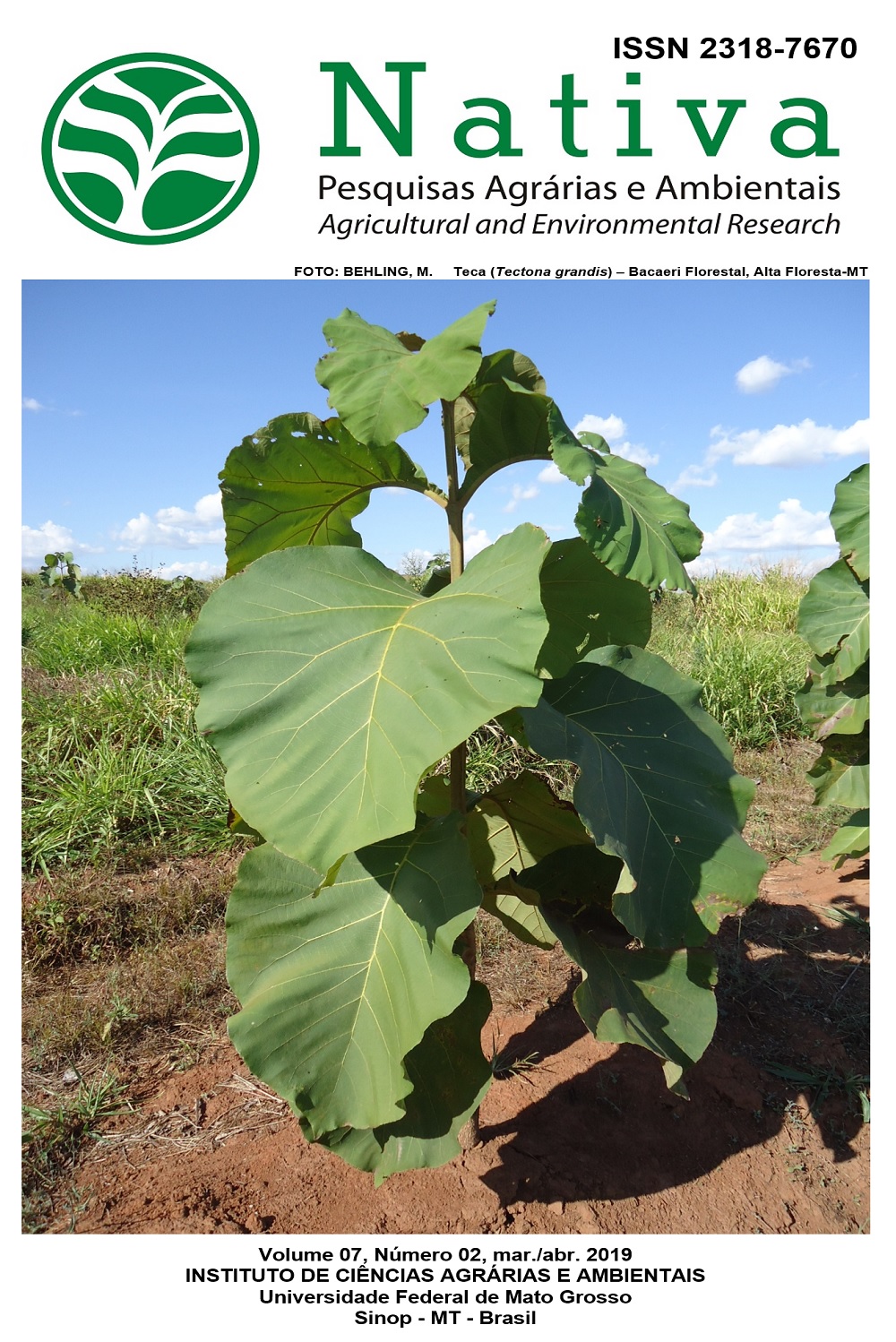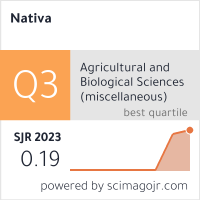PRECISÃO DO MODELO DIGITAL DE ELEVAÇÃO (SRTM-Topodata) COM BASE EM DADOS DE PROJETOS DE APROVEITAMENTOS HIDRELÉTRICOS
DOI:
https://doi.org/10.31413/nativa.v7i2.6356Resumo
A precisão altimétrica do Modelo Digital de Elevação – MDE tem sido tema de diversos estudos. Essa precisão exerce forte influência sobre as informações extraídas desses dados. Nesse contexto, o presente estudo compara dados observados em projetos de aproveitamentos hidrelétricos com dados extraídos do MDE. A comparação de dados altimétricos de informações extraídas pelo MDE com as contidas no Projeto Básico Ambiental – PBA desses empreendimentos, assumido como informação verdadeira, foi feita com o intuito de analisar o erro das informações extraídas do MDE em relação aos dados contidos no PBA e assim verificar a confiança nesse tipo de estimativa. Foram calculados o erro e o coeficiente de determinação de Pearson entre a altura da barragem (determinada com base no MDE) em relação à altura apresentada no PBA. Também foi comparada uma seção topobatimétrica do PBA com a mesma seção extraída pelo MDE. O erro relativo médio e o coeficiente de determinação entre as cinco alturas (estimadas e de projeto) foi de 11% e 0,874, respectivamente. O coeficiente de determinação, o erro médio quadrático e o erro médio entre as seções foram de 0,98, 1,56 e -0,02, respectivamente. A análise evidenciou que há erros em relação às informações extraídas do MDE. Entretanto, considerando a escala utilizada nesse estudo, os erros foram menores que os observados na literatura.
Palavras-chave: MDE validação, Altura de barragem, Seção topobatimétrica.
ALTIMETRY ACCURACY OF THE DIGITAL ELEVATION MODEL (SRTM-Topodata) BASED ON DESIGNS OF HYDROPOWER PLANTS DATA
ABSTRACT:
The altimetry accuracy measurements of the Digital Elevation Model - DEM have been the subject of several studies. This accuracy plays an important role on information extracted from these data. In this context, this study compares data observed in designs of hydroelectric power plants with data extracted from the DEM. The comparison between the altimetry of data extracted from the DEM with those contained in the Basic Environmental Project - BEP of these facilities, assumed as the true information, was done with the purpose of analyzing the error of the information extracted from the DEM in relation to the data contained in the BEP and thus verifying the confidence in this type of estimate. The error and the coefficient of determination between the dam height (determined based on the DEM) and the dam height presented in the BEP were calculated. Moreover, a river cross section published in the BEP was contrasted with the same cross section extracted from the DEM. The mean relative error and the coefficient of determination between the five heights (estimated and projected) was 11% and 0.874, respectively. The coefficient of determination, mean square error and mean error between sections were 0.98, 1.56 and -0,02, respectively. The analysis evidenced that there are errors in relation to the information extracted from the DEM. However, considering the scale used in this study, the errors were smaller than those observed in the literature.
Keywords: DEM validation, dam height, cross section.
Referências
DIXON, B.; EARLS, J., Resample or not?! Effects of resolution of DEMs in watershed modeling. Hydrological processes, Chichester, v. 23, n. 12, p. 1714–1724, apr. 2009. DOI: http://dx.doi.org/10.1002/hyp.7306
ERSKINE, R. H.; GREEN, T.R.; RAMIREZ, J. A.; MACDONALD, L. H. Digital Elevation Accuracy and Grid Cell Size: Effects on Estimated Terrain Attributes. Soil Science Society of America Journal, Madison, v. 71, n. 4, p. 1371-1380, may. 2007. DOI: http://dx.doi.org/10.2136/sssaj2005.0142
GHUMMAN, A. R.; AL-SALAMAH, I.S.; ALSALEEM, S. S.; HAIDER, H. Evaluating the impact of lower resolutions of digital elevation model on rainfall-runoff modeling for ungauged catchments. Environmental Monitoring and Assessment, v. 189, n. 54, jan. 2017. DOI: https://dx.doi.org/10.1007/s10661-017-5766-0
GONGA-SAHOLIARILIVA, N.; GUNNELL, Y.; PETIT, C.; MERING, C. Techniques for quantifying the accuracy of gridded elevation models and for mapping uncertainty in digital terrain analysis. Progress in Physical Geography, London, v. 35, n. 6, p. 739-764, jul. 2011. DOI: https://dx.doi.org/10.1177/0309133311409086
HABTEZION, N.; TAHMASEBI NASAB, M.; CHU, X. How does DEM resolution affect microtopographic characteristics, hydrologic connectivity, and modelling of hydrologic processes?. Hydrological processes, Chichester, v. 30, n. 25, p. 4870-4892, dez. 2016. DOI: http://dx.doi.org/10.1002/hyp.10967
LARENTIS, D. G.; COLLISCHONN, W.; OLIVEIRA F.; TUCCI C. E. M. Gis-based procedures for hydropower potential spotting. Energy, Oxford, v. 35, n. 10, p. 4237-4243, out. 2010. DOI: https://dx.doi.org/10.1016/j.energy.2010.07.014
LI, X.; ZHANG, Y.; JIN, X.; HE. Q.; ZHANG, X. Comparison of digital elevation models and relevant derived attributes. Journal of Applied Remote Sensing, Bellingham, v. 11, n. 4, p. 1-23. dez. 2017. DOI: https://dx.doi.org/10.1117/1.JRS.11.046027
LIN, S.; JING, C.; COLES, N. A.; CHAPLOT, V.; MOORE, N. J.; WU, J.; Evaluating DEM source and resolution uncertainties in the soil and water assessment Tool. Stochastic Environmental Research and Risk Assessment, Berlin, v. 27, n. 1, p. 209-221, 2013. DOI: https://dx.doi.org/10.1007/s00477-012-0577-x
LÓPEZ-VICENTE, M.; ÁLVAREZ, S. Influence of DEM resolution on modelling hydrological connectivity in a complex agricultural catchment with woody crops. Earth Surface Processes and Landforms, Sussex, v. 43, n. 7, p. 1403-1415, jan. 2018. DOI: http://dx.doi.org/10.1002/esp.4321
MARINI L. B.; JUNIOR, J. M.; RAMOS, A. P. M.; PARANHOS FILHO, A. C.; BARROS, W. M.; HIGA, L. T. Analysis of the Altimetric Accuracy of SRTM and Aster Digital Surface Models and their Application to the 3D Representation of Nhecolândia Pantanal. Anuário do Instituto de Geociências, Rio de Janeiro, v. 40, n. 3, p. 48-54, set. 2017. DOI: http://dx.doi.org/10.11137/2017_3_48_54
RABUS, B.; EINEDER, M.; ROTH, A.; BAMLER, R. The shuttle radar topography mission- a new class of digital elevation models acquired by spaceborne radar. ISPRS Journal of Photogrammetry and Remote Sensing, Amsterdam, v. 57, n. 4, p. 241-262, fev. 2003. DOI: https://dx.doi.org/10.1016/S0924-2716(02)00124-7
REDDY, A. S.; REDDY, M. J. Evaluating the influence of spatial resolutions of DEM on watershed runoff and sediment yield using SWAT. Jornal of Earth System Science, New Delhi, v. 124, n. 7, p. 1517-1529, set. 2015. DOI: https://dx.doi.org/10.1007/s12040-015-0617-2
REXER, M.; HIRT, C. Comparison of free high resolution digital elevation data sets (ASTER GDEM2, SRTM v2.1/v4.1) and validation against accurate heights from the Australian national gravity database. Australian Journal of Earth Sciences, Victoria, v. 61, n. 2, p. 213-226, out. 2014. DOI: https://dx.doi.org/10.1080/08120099.2014.884983
SOUSA, T. M. I.; PAZ, A. R. How to evaluate the quality of coarse-resolution DEM-derived drainage networks. Hydrological Processes. Chichester, v. 31, p. 3379-3395, ago. 2017. DOI: https://dx.doi.org/10.1002/hyp.11262
TAN, M. L.; FICKLIN, D. L.; DIXON, B.; YUSOP, Z.; CHAPLOT, V. Impacts of DEM resolution, source, and resampling technique on SWAT-simulated streamflow. Applied Geography, Oxford, v. 63, p. 357-368, set. 2015. DOI: https://dx.doi.org/10.1016/j.apgeog.2015.07.014
WALKER, J. P.; WILLGOOSE, G. R. On the effect of digital elevation model accuracy on hydrology and geomorphology. Water Resources Research, Washington, v. 35, n. 7, p. 2259–2268, jun. 1999. DOI: http://dx.doi.org/10.1029/1999WR900034
ZHOU, L.; XIONG. L. Natural topographic controls on the spatial distribution of poverty-stricken counties in China, Applied Geography, Oxford, v. 90, p. 282-292, jan. 2018. DOI: https://dx.doi.org/10.1016/j.apgeog.2017.10.006
Downloads
Publicado
Edição
Seção
Como Citar
Licença
Direitos Autorais para artigos publicados nesta revista são do autor, com direitos de primeira publicação para a revista. Em virtude de a aparecerem nesta revista de acesso público, os artigos são de uso gratuito, com atribuições próprias, em aplicações educacionais e não-comerciais.
A artigos publicados nessa revista, podem ser reproduzidos parcialmente ou utilizados como referência por outros autores, desde que seja cita a fonte, ou seja, a Revista Nativa.
Copyright for articles published in this journal are the authors, with first publication rights granted to the journal. The journal shows open access, and articles are free to use, with proper attribution, in educational and non-commercial.
The articles published in this journal may be reproduced in part or used as a reference by other authors, provided that the source is quoted.






